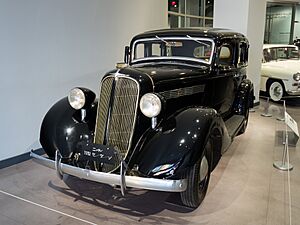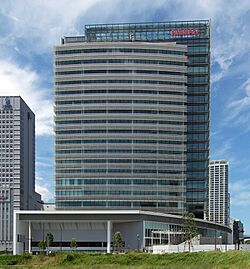Nissan facts for kids

Logo since 2020
|
|

Nissan headquarters in Yokohama, Kanagawa Prefecture
|
|
|
Trade name
|
Nissan Motor Corporation |
|---|---|
|
Native name
|
日産自動車株式会社
|
|
Romanized name
|
Nissan Jidōsha kabushiki gaisha |
|
Formerly
|
Jidosha-Seizo (1933–1934) |
| Public | |
| Traded as |
|
| Industry | Automotive |
| Founded | 26 December 1933 |
| Founders |
|
| Headquarters |
Nishi-ku, Yokohama, Kanagawa Prefecture
,
Japan
|
|
Area served
|
Worldwide |
|
Key people
|
|
| Products | Automobiles, luxury vehicles, commercial vehicles, outboard motors, forklift trucks |
|
Production output
|
|
| Revenue | |
|
Operating income
|
|
| Total assets | |
| Total equity | |
| Owner | Renault (15% voting rights) |
|
Number of employees
|
131,461 (2022) |
| Divisions |
|
| Subsidiaries |
List
Transportation:
Nissan Commercial Vehicles Dongfeng Motor Co., Ltd. (50%) Nissan Shatai (43%) Mitsubishi Motors (24.5%) NMKV (50%) Other: Nissan Techno Jatco International: Nissan Australia Nissan Ibérica Nissan India Renault Nissan Automotive India Private Limited Nissan Indonesia Nissan New Zealand Nissan Philippines Nissan South Africa Nissan UK Nissan USA |
Nissan Motor Co., Ltd. is a big Japanese company that makes cars. It's known around the world as Nissan. The company's main office is in Yokohama, Japan. Nissan sells its cars under the Nissan and Infiniti names. It also used to sell cars under the Datsun brand. For high-performance cars, Nissan has special brands called Nismo and Autech.
Nissan has been part of a big team-up called the Renault–Nissan–Mitsubishi Alliance since 1999. This alliance includes Nissan, Mitsubishi Motors from Japan, and Renault from France. As of November 2023, Renault owns 15% of Nissan, and Nissan owns 15% of Renault. Nissan also owned a part of Mitsubishi Motors.
In 2017, Nissan was the sixth-largest car maker in the world. By 2022, it was the ninth-largest, with sales of $78 billion. Nissan faced some financial challenges in recent years. In February 2025, Nissan decided not to merge with Honda Motor Company, as it wanted to be an equal partner.
Contents
The Story of Nissan Cars
How the Datsun Brand Started in 1914
The company that would become Nissan started on July 1, 1911. It was called Kwaishinsha Motor Car Works. In 1914, they made their first car, named the DAT.
The name DAT came from the first letters of the last names of the company's three main investors:
- Kenjiro Den
- Rokuro Aoyama
- Meitaro Takeuchi
The company changed its name a few times. In 1925, it became DAT Jidosha & Co., Ltd. DAT Motors mostly built trucks back then. There weren't many people buying passenger cars. Trucks were also important for rebuilding after the big 1923 Great Kantō earthquake.
In 1926, DAT Motors joined with another company, Jitsuyo Jidosha Co., Ltd. They became DAT Jidosha Seizo Co., Ltd. In 1931, DAT made a new, smaller car called the Datsun Type 11. They first called it "Datson," meaning "Son of DAT." Later, in 1933, the last part of the name was changed to "sun" to avoid the Japanese word for "loss." That's how the famous name "Datsun" came to be.
In 1933, the company moved to Yokohama and changed its name to Jidosha-Seizo Co., Ltd., which means "Automobile Manufacturing Share Company."
The Nissan Name Appears
In 1928, a person named Yoshisuke Aikawa started a holding company called Nihon Sangyo. The name 'Nissan' was a short way to say Nihon Sangyo on the stock market. This company, also known as the Nissan Group, owned many businesses, including those that made car parts. Aikawa started making cars in 1933.
The Nissan Group grew very large, with 74 companies. In 1933, DAT Jidosha Seizo became part of Tobata Casting, which was a Nissan company. This was the start of Nissan making cars.
Nissan Motor Company Begins
In 1934, Aikawa created a new company just for making cars. He called it Nissan Motor Co., Ltd. In 1935, Nissan finished building its factory in Yokohama. They started shipping Datsun cars to other parts of Asia and the Americas. This factory was also where the first car made using a full assembly system was built in Japan. During this time, Nissan also built trucks, airplanes, and engines for the military.
Growing in America and Beyond
Nissan learned a lot from American car-making technology. An American engineer named William R. Gorham helped Nissan use advanced methods. Many of Nissan's early designs and factory setups came from the Graham-Paige Company in the US.
In the 1950s, Nissan decided to sell its cars all over the world. They saw that their small Datsun cars could be popular in places like Australia and the United States. Nissan showed the Datsun Bluebird at a car show in Los Angeles in 1958. In 1960, Nissan started its US company, Nissan Motor Corporation U.S.A..
Nissan kept making its cars better with new technology and stylish designs. Cars like the Datsun Fairlady roadsters, the Datsun 510, and the Datsun 240Z became very popular. By 1970, Nissan was one of the biggest car exporters in the world.
When the 1973 oil crisis happened, people wanted smaller, fuel-efficient cars. Nissan built new factories in Mexico, Australia, New Zealand, Taiwan, the United States, and South Africa to meet this demand. Nissan opened its first North American factory in Mexico in 1966. In the US, Nissan built a factory in Smyrna, Tennessee, in 1980, which first made trucks. Later, it started making popular cars like the Nissan Altima and the Nissan Leaf electric car.
In the early 1980s, Datsun was the top-selling Japanese car brand in Europe. Nissan also worked with other car companies. For example, they partnered with Alfa Romeo in Italy to make the Nissan Cherry and the Alfa Romeo Arna.
Nissan continued to expand globally. In 2001, they opened a factory in Brazil. In 2005, they started operations in India. Nissan also has a big partnership in China with Dongfeng Motor.
Joining with Prince Motor Company
In 1966, Nissan joined with the Prince Motor Company. This brought more fancy cars like the Nissan Skyline and Nissan Gloria into Nissan's lineup. The "Prince" name was eventually stopped for cars, but the Skyline and Gloria continued under the Nissan name. The Skyline is still made today as part of the Infiniti luxury brand.
Nissan also started using "Miss Fairladys" at their showrooms in Japan. These were women who helped introduce new cars, like the Datsun Fairlady 1500. The name "Fairlady" came from a popular play called My Fair Lady.
The Renault Alliance

In 1999, Nissan was having serious money problems. So, they formed an alliance with Renault, a car company from France. This partnership helped Nissan recover. Many people think this was one of the most amazing company comebacks ever. Nissan started making record profits and brought out many new and exciting cars.
In January 2023, Renault and Nissan changed their agreement. Renault reduced its ownership in Nissan to 15%, matching Nissan's ownership in Renault. This made both companies more equal partners. They also agreed to work together on new projects, especially for electric cars.
Recent Challenges and Changes
Starting in 2019, Nissan had to make some tough decisions, including reducing its workforce. The company faced challenges from the COVID-19 pandemic and other issues. In 2020, Nissan closed factories in Indonesia and Spain and left the South Korean car market.
In November 2024, Nissan announced a plan to improve its business. This included cutting jobs and reducing how many cars it produces globally.
In December 2024, Nissan announced it was considering merging with Honda. However, in February 2025, both companies decided not to go through with the merger. Nissan wanted to be an equal partner, not a smaller part of Honda. In March 2025, Ivan Espinosa became the new CEO of Nissan.
Nissan's Cool Technologies
Nissan has always worked on new technologies. In 1982, they started using robots to build cars in their factories.
Electric Cars

Nissan has been making electric cars for a long time, starting in 1946. In 2010, they launched the Nissan Leaf, which was one of the first widely available all-electric cars. For almost ten years, the Leaf was the best-selling plug-in electric car in the world. By December 2020, over 500,000 Leaf cars had been sold globally.
Nissan also makes the Nissan e-NV200, an all-electric commercial van. In 2023, Nissan announced plans to make electric cars with new solid-state batteries by 2028. They also plan to build electric versions of their popular Qashqai and Juke models in their UK factory.
Self-Driving Cars
Nissan has been working on driverless cars. In 2013, they showed a Nissan Leaf fitted with their self-driving technology. This car was even allowed to drive on public roads in Japan for testing. Nissan engineers use these tests to make their self-driving software better.
Nissan's Partnerships with Other Car Companies
Nissan has worked with many other car companies around the world.
- In Australia, Nissan shared models with Ford Australia from 1989 to 1992. For example, a version of the Nissan Pintara was sold as the Ford Corsair.
- In North America, Nissan partnered with Ford to make minivans like the Mercury Villager and the Nissan Quest.
- In Europe, Nissan and Ford worked together to produce SUVs like the Nissan Terrano II.
- Nissan also worked with Alfa Romeo in the 1980s to build the Alfa Romeo Arna.
- Nissan and General Motors (GM) cooperated on commercial vehicles in Europe. GM also sold a version of the Nissan NV200 van as the Chevrolet City Express.
- Nissan and Mitsubishi Motors work together to develop small "kei cars" in Japan. In 2016, Nissan bought a controlling share in Mitsubishi Motors.
- In March 2023, Nissan and Honda signed an agreement to work together on electric vehicle parts and car software.
The Renault-Nissan-Mitsubishi Alliance
The alliance with Renault started in 1999. It was the first time a Japanese and French car company teamed up like this. Nissan and Renault each own a part of the other company.
In 2010, Daimler AG (which makes Mercedes-Benz cars) also joined the alliance, allowing the companies to share technology and development costs.
The alliance also worked with Russian Technologies to control AvtoVAZ, Russia's largest car company, which makes Lada cars. Nissan later sold its part of this venture in 2017.
In 2013, the Renault-Nissan Alliance sold one out of every ten cars worldwide, making them the fourth-largest car maker. In March 2023, Renault and Nissan changed their stock ownership to be more equal partners.
Nissan Brands and Look
Car Brands
- Nissan: This is the main brand for most of Nissan's cars and trucks sold globally.
- Datsun: Until 1983, many Nissan cars sold outside Japan were called Datsun. The Datsun brand was brought back in 2013 for cars sold in new markets, but sales ended in 2022.
- Infiniti: Since 1989, Nissan has used the Infiniti brand for its luxury cars.
- Nismo: This is Nissan's special division for high-performance and racing cars. Nismo stands for "Nissan Motorsport International Limited."
-
The "classic" Datsun logo, based on the flag of Japan and Japan's nickname as the "Land of the Rising Sun"
Company Look
Nissan has changed its company logo over the years. In July 2020, Nissan introduced new logos for both the company and its car brands. These new logos were part of a fresh look for the company.
In Japan, Nissan used to have different types of dealerships with names like "Nissan Blue Stage" and "Nissan Red Stage." These names came from older dealership networks that sold different kinds of Nissan cars. Now, Nissan uses one main "Nissan" sign for its dealerships around the world.
Nissan's Leaders
Here are some of the people who have led Nissan over the years:
- Yoshisuke Aikawa (1933–1939)
- Katsuji Kawamata (1957–1973)
- Takashi Ishihara (1977–1985)
- Yutaka Kume (1985–1992)
- Yoshikazu Hanawa (1996–2000)
- Carlos Ghosn (2000–2017)
- Hiroto Nishikawa (2017–2019)
- Makoto Uchida (2019–2025)
- Ivan Espinosa (2025–present)
What Nissan Makes
Cars and Trucks
Nissan makes a wide variety of cars and trucks. They started by selling them in Japan and then exported them worldwide. Nissan is famous for its sports cars, like the Datsun Fairlady Roadsters and the Z-car, which first came out in 1969. The Nissan GT-R is another powerful sports car they make.
In 1985, Nissan created Nismo to develop high-performance versions of its cars. One of their latest models is the 370Z Nismo.
Nissan also makes small "kei cars" in Japan, often working with other Japanese car makers like Mitsubishi Motors. In China, Nissan produces cars with the Dongfeng Motor Group.
In 2011, Nissan launched its Nissan Commercial Vehicles brand in North America. This brand focuses on vans, pickup trucks, and other vehicles for businesses.
Nissan introduced its Nissan Intelligent Mobility idea in 2016. This vision is about making cars smarter, safer, and more fun to drive. Many Nissan vehicles, like the Rogue and Leaf, have this technology.
Trucks
The Nissan Cabstar is a line of pickup trucks and light commercial vehicles sold in many parts of the world. It shares its base with the Nissan Caravan.
The Nissan Titan is a large pickup truck made for the North American market. It was first introduced in 2004.
Other Products
Nissan has also been involved in other businesses. They used to have a mobile phone service. Nissan also owns Nissan Marine, which makes motors for boats.
Nissan used to build rocket motors for space vehicles, but this part of the company was sold in 2000.
Marketing and Sponsorships
Nismo is Nissan's motorsports division, started in 1984. Nismo cars have competed in many races around the world.
Nissan has also sponsored sports events. From 1987 to 2007, they sponsored the Los Angeles Open golf tournament. Since 2015, Nissan has been the name sponsor for Nissan Stadium in Nashville, Tennessee, which is home to the Tennessee Titans football team. Nissan is also an official sponsor of the Heisman Trophy and the UEFA Champions League. Since 2019, Nissan has sponsored Nissan Arena in Brisbane, Australia.
Where Nissan Makes Cars
Nissan has factories and research centers all over the world.
Asia
- Japan: Yokosuka, Kaminokawa, Kanda, Yokohama, Iwaki, Hiratsuka, Nagoya, Matsusaka, Tsu, Uji.
- China: Wuhan, Huadu District (Guangzhou), Xiangyang, Zhengzhou, Dalian.
- Taiwan: Miaoli.
- Malaysia: Segambut, Serendah.
- Vietnam: Hanoi.
- Indonesia: Cikampek.
- Thailand: Bangna.
- India: Chennai.
Americas
- United States: Smyrna, Canton, Decherd.
- Mexico: Aguascalientes (2 plants), Cuernavaca.
- Brazil: São José dos Pinhais, Resende.
- Argentina: Santa Isabel.
Africa
- Morocco: Tangier.
- Egypt: 6th of October City.
- Kenya: Thika.
- South Africa: Rosslyn.
Europe
- Spain: Ávila.
- United Kingdom: Sunderland.
- France: Flins (Renault factory).
Images for kids
See also
 In Spanish: Nissan para niños
In Spanish: Nissan para niños



















